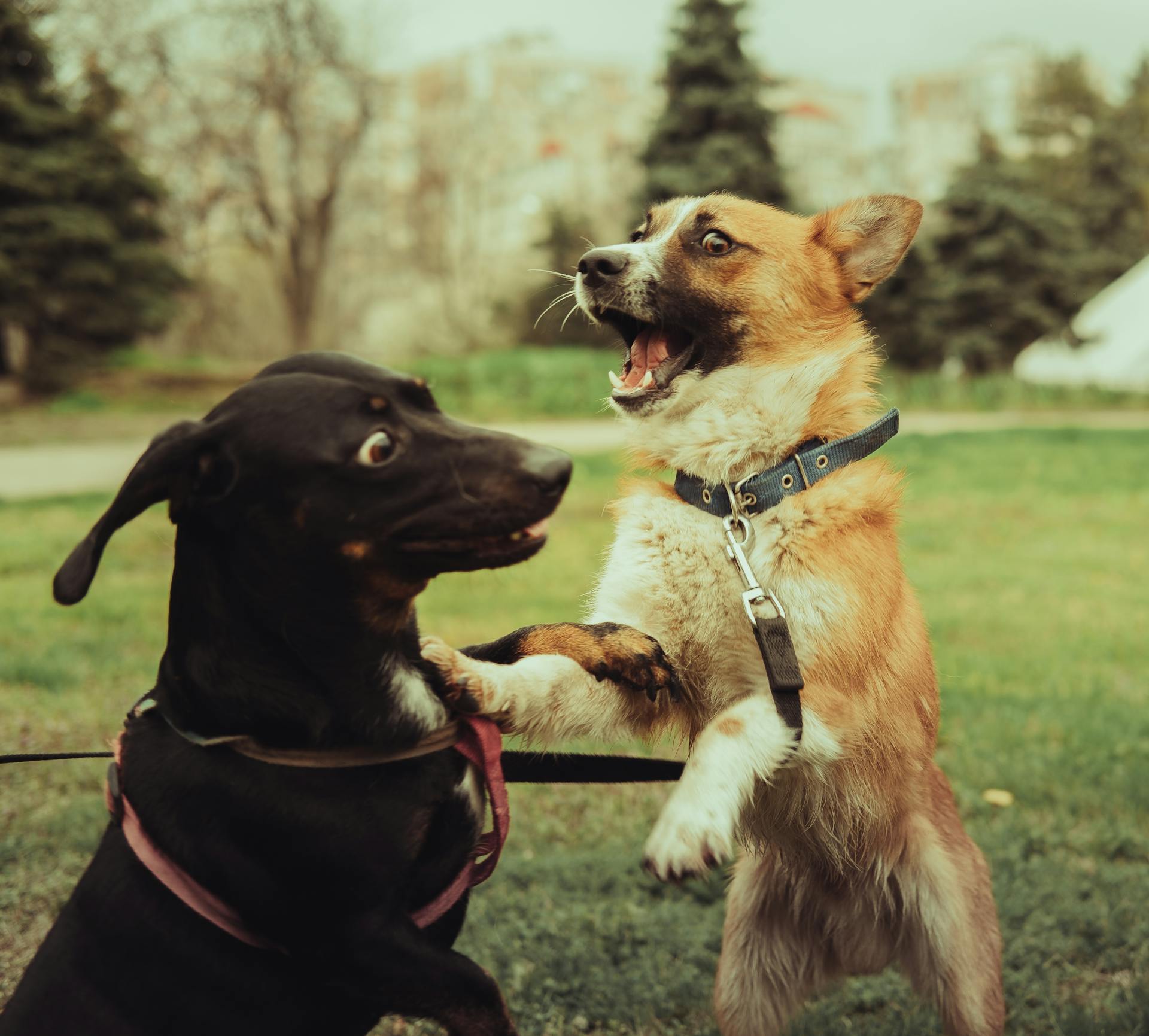
Starting a dog boarding business requires a comprehensive plan to ensure the well-being of the dogs in your care. A business plan will help you determine your target market, pricing, and operational costs.
Research suggests that the average cost of dog boarding in the US is around $25-30 per day. This will help you set your pricing strategy.
To create a safe and comfortable environment for your furry clients, you'll need to invest in kennels, bedding, and toys. According to our article, a good rule of thumb is to allocate 10-15% of your revenue towards facility maintenance and supplies.
A typical dog boarding facility can accommodate around 20-30 dogs at a time. This will help you determine the size of your facility and the number of staff you'll need to hire.
Suggestion: What Vaccines Do Dogs Need to Be Boarded?
Market Analysis
The market analysis section of your dog boarding business plan is crucial in understanding your target demographic and the competition you'll face. The pet grooming and boarding industry has a market size of $8.4 billion in 2021 and is growing rapidly due to people having full working days and looking for proper places to look after their pets.
To conduct market research, start by researching local competitors who provide overnight care for dogs and understanding your target customers. You can then use surveys, interviews, and online research to craft your market research.
A thorough market analysis should include a competitor analysis, identifying services, pricing, and unique selling points (USPs) of local competitors, as well as their market share and customer reviews. It's also essential to consider regulatory and compliance requirements, such as zoning regulations and licenses needed to operate.
Industry Overview
The Pet Grooming & Boarding industry has experienced rapid growth, with a market size of $8.4bn in 2021. This growth is largely driven by the increasing preference for having pets, which has led to a greater awareness of their health and hygiene requirements.
Pet owners are looking for reliable and trustworthy services to cater to their pets' needs, and the dog boarding industry has seen a significant surge in demand. People with full working days are seeking proper places to look after their pets, which has fueled the growth of dog boarding services.
The industry is expected to continue growing as more pet owners become aware of the importance of proper care and attention for their pets.
Pet Owner Income
Pet boarding business owners can earn a significant income, but it's not all profit. A business with 20 dog runs at a rate of $50 per day can generate $1,000 per day.
Net income, however, is a different story. Overhead costs like utilities, rental/mortgage, staff costs, and other expenses need to be subtracted from the gross income.
Discover more: Dog Boarding Business Start-up Costs
Business Planning
Creating a business plan for your dog boarding business is a crucial step in getting started. You'll need to consider what types of pets you'll service, whether you'll operate from your home or a boarding facility, and the maximum number of pets you can care for at once.
To determine the type of services you'll offer, research similar businesses in your area and speak to vets and rescue groups to see what's in demand. You may decide to offer daycare services or just overnight boarding. The key is to identify a niche and stick to it.
Your business plan should also outline how you'll obtain startup financing. If you have a good chunk of savings, this may be a straightforward decision. However, if not, you may need to explore alternatives like bank loans, online loans, or crowdfunding.
To get started, break down your business plan into smaller sections, such as the 8 necessary items listed below:
- Business description
- Market analysis
- Services offered
- Marketing and sales strategy
- Financial projections
- Management and organization
- Operations plan
- Financial plan
Remember, your business plan is a living document that will evolve as your business grows. Be sure to regularly review and update it to ensure you're on track to meet your goals.
Market Research
To create a dog boarding business plan, it's essential to conduct thorough market research. This involves understanding your target customers and their preferences. You can start by researching local competitors who provide overnight care for dogs.
In your market research, you'll want to analyze the services, pricing, and unique selling points of local competitors. This will help you identify market gaps and opportunities. You can also use surveys, interviews, and online research to gather information about your target customers.
Here are some key areas to focus on in your market research:
- Market trends and demands in pet care and boarding
- Competitor analysis, including market share and customer reviews
- Customer segmentation and their specific needs and preferences
- Pricing strategies and their impact on profitability
Importance of
Market research is crucial for any business, and a well-crafted business plan is essential for a dog boarding business. It helps you think about and set goals for your business, keeping you on track and focused on your vision.
A business plan forces you to think through every aspect of your business, from services to target market. This includes analyzing financial goals and researching overhead costs.
The pet boarding and grooming services industry is a whopping $11 billion industry, providing a huge opportunity for growth. A well-detailed business plan can help you define how to take a chunk of this market and stand out from competitors.
A business plan also gives you a clear and targeted way to communicate your vision to others, providing a map for everyone on your business journey.
If this caught your attention, see: Dog Daycare Business Plan
Conduct Research and Gain Experience
Conducting thorough research and gaining experience are crucial steps in preparing for a pet boarding business. This involves more than just having experience with your own pets, as pet owners will want to know that their pets are in good hands.
To be properly prepared, it's essential to be certified in key areas such as dog grooming, pet first aid, and dog handling. These certifications will give pet owners confidence in your ability to care for their pets.
Volunteering at a veterinary clinic or animal shelter can also provide valuable hands-on experience. It's a great way to get comfortable with large groups of pets and gain a deeper understanding of their needs.
Getting a side gig walking dogs or pet sitting can give you experience with different breeds and personality types. This will help you develop the skills and confidence needed to care for a variety of pets.
Conducting Market Research
Conducting market research is a crucial step in creating a solid business plan. It helps you understand your target demographic, identify market gaps, and determine the level of competition you'll face.
Start by researching local competitors who provide overnight care for dogs, as this will give you a clear picture of the market landscape. You can also use surveys, interviews, and online research to gather more information.
To craft your market research, identify the specific demands and preferences of pet owners, such as the types of services they're looking for and the price range they're willing to pay.
Conduct a competitor analysis by studying the services, pricing, and unique selling points (USPs) of local competitors. This will help you understand their market share and customer reviews.
Customer segmentation is also essential in market research. Identify your target customers and their preferences, and analyze different customer segments and their needs.
Some key factors to consider in your market research include market trends and demands, competitor analysis, customer segmentation, pricing strategies, and regulatory and compliance requirements.
Here are some key areas to focus on in your market research:
- Market trends and demands
- Competitor analysis
- Customer segmentation
- Pricing strategies
- Regulatory and compliance requirements
By thoroughly conducting market research, you'll be able to create a comprehensive business plan that takes into account the needs and preferences of your target customers.
Vaccination and Health Requirements
When starting a dog business, vaccination protocols are crucial to ensure the health and safety of both dogs and customers. All dogs should be fully vaccinated, including rabies and DA2PPV.

Dogs need to be protected from diseases like distemper, adenovirus, parainfluenza, and parvo, which can be prevented with the right vaccinations. Canine influenza is another highly contagious disease that requires vaccination.
At the time of a customer's reservation, proof of vaccinations should be required in advance of the dog's stay. This helps prevent the spread of diseases and ensures a safe environment for all dogs.
Developing a good working relationship with a local veterinarian is essential to stay up-to-date on current vaccine protocols. They can provide advice on the latest vaccine requirements and recommend necessary vaccinations.
Dogs can also contract Leptospirosis, but this is typically not vaccinated for unless there's an outbreak in the area.
Location and Setup
Choosing the right location for your dog boarding business is crucial. It should be in reasonable proximity to your customers in residential areas, while complying with local zoning laws.
Accessibility is key, so pick a location that's easily accessible for pet owners. A location that's too far away can deter people from using your services.
You'll need to consider the size of the location too. A small space can make it less lucrative as pets usually like to play around. A bigger space will give them room to exercise and play.
Think about the theme and decor of your facility. It should be attractive and help your business stand out.
Choosing the Ideal Location
Choosing the Ideal Location is crucial for a dog boarding business. You'll want to locate in reasonable proximity to your customers in residential areas.
The most favorable zoning for a dog boarding/kennel business is Agricultural. However, you may still need to apply for approval under zoning categories such as Special Exception or Conditional Use.
In some areas, a dog boarding facility may be "permitted by right", which means no hearing would be needed. This can save you time and stress in the long run.
To be a good neighbor, you must take steps to eliminate outdoor barking, which is the number one complaint neighbors have about dog boarding businesses. This could involve soundproofing or designing a facility with indoor play areas.
The governing entity, such as a town or township, is required to advertise the hearing in a newspaper of general circulation in the area and also by mail to notify all neighbors in a certain radius of the proposed business.
Gather Supplies

When setting up your pet boarding facility, it's essential to gather all the necessary supplies to keep your canine clients happy and healthy. You'll want to stock up on food and treats, as well as dishes for food and water.
A well-stocked facility is crucial, so make sure to have a variety of toys on hand to keep your furry friends entertained. Pet beds and kennels are also a must-have.
Potential customers will likely want to tour your facility before handing their pet off for a stay, so it's crucial that your supplies are well-stocked, clean, and organized. This means keeping cleaning supplies on hand to keep the facility spotless.
Here's a list of essential supplies to get you started:
- Food and treats
- Dishes for food and water
- Toys
- Pet beds and kennels
- Waste bags and potty pads
- Leashes and harnesses
- Cleaning supplies
- Animal first aid kits
Services and Pricing
As you're planning your dog boarding business, it's essential to decide on the services you'll offer. This will help you stand out from the competition and become a one-stop shop for your target audience.
The services you offer will determine how you differentiate yourself from the competition. It's a good practice to take suggestions from your target audience to ensure you're meeting their needs.
To determine your pricing strategy, you'll need to consider various factors, including costs, competitor pricing, demand, and value-added services.
Here are some key considerations for pricing:
- Costs: Factor in overhead, staff wages, food, utilities, and other operational costs.
- Competitor Pricing: Research local competitors’ pricing to stay competitive.
- Demand: Consider peak seasons and adjust pricing accordingly.
- Value-added Services: Price additional services like grooming or training separately.
- Customer Segments: Different pricing for different customer segments, if applicable.
By offering package deals and discounts, you can attract more customers and make your business more accessible to people who may not have been able to afford it otherwise.
Pet Owner Requirements
As a pet owner, you have specific requirements when it comes to boarding facilities. Safety and security are top priorities, with features like secure fencing, surveillance cameras, and proper kennel design.
You'll want to ensure the facility has emergency protocols in place, such as a plan for handling medical emergencies or natural disasters.
Cleanliness and hygiene are also crucial, with regular cleaning and sanitization, pest control, and the use of veterinary-approved cleaning agents.
Proper shelter and bedding, temperature control, and adequate space for movement are essential for your pet's comfort and well-being.
Here are some key features to look for in a boarding facility:
Trained and caring staff are also vital, with knowledge of animal behavior, adequate staffing levels, and emergency veterinary access.
Transparent policies and communication are essential, including regular updates and reports to owners, flexible pick-up and drop-off times, and proper feeding, special diet accommodations, and medication administration.
Services to Offer
Deciding what services to offer is crucial in standing out from the competition. It's a good practice to take suggestions from your target audience to become a one-stop shop for them.
Dog boarding facilities can offer a range of services, including grooming and medical help. Many facilities serve as play areas for pets.
You don't need special certifications to offer dog grooming services, but it's essential to be a professional dog groomer. To offer limited grooming services, you can even just provide a bath on the day the dog goes home.
Consider hiring or leasing space to an experienced groomer to further expand your grooming services.
A different take: Beginner Dog Grooming
Pricing and Packages
Pricing your services correctly is essential for any business, including a pet boarding business. It helps you make profits while keeping prices that your customers are willing to pay.
You should factor in various costs such as overhead, staff wages, food, utilities, and other operational costs. Research local competitors' pricing to stay competitive.
Consider peak seasons and adjust pricing accordingly, as demand is higher during summer vacation months and holidays. Pricing additional services like grooming or training separately can also help.
Different pricing for different customer segments, if applicable, is another consideration. For example, offering a monthly discount can help build a strong client base and project anticipated income.
Here's a list of factors to consider when determining pricing:
- Costs: overhead, staff wages, food, utilities, and other operational costs.
- Competitor Pricing: research local competitors' pricing.
- Demand: consider peak seasons and adjust pricing accordingly.
- Value-added Services: price additional services like grooming or training separately.
- Customer Segments: different pricing for different customer segments, if applicable.
Remember, it's essential to be reasonable and fair while making money.
Hiring and Training
You'll need to find skilled and efficient people to help you with the dog boarding business. They'll not only make your task easy but also gain your customer's trust as their pets will be in good hands.
Choose employees who love dogs and have experience working with them. They need training in canine first aid and emergency protocols, as well as an understanding of dog behavior.
Having employees on hand 24/7 will reassure pet owners that their pets will be safe even if an emergency should arise late at night. This is especially important since animals will be under your care overnight.
You'll need to obtain an Employee Identification Number (EIN) from the IRS once you hire employees. This will help you with tax documents and other administrative tasks.
Investing in payroll software will make paying your employees and handling tax documents much easier. This will save you time and reduce stress.
Suggestion: What Vaccines Do Dogs Need for Boarding?
Frequently Asked Questions
How profitable is a dog boarding business?
According to industry estimates, a dog boarding business typically has a relatively low average profit margin of around 10%. However, profitability can vary significantly depending on factors like location and operational efficiency.
How do you scale a dog boarding business?
To scale a dog boarding business, consider expanding your facilities, services, and online presence through strategic partnerships and digital marketing. This will help increase capacity, attract more customers, and streamline operations.
Who is the target market for kennels?
The primary target market for kennels are pet owners, but kennels can also cater to specific types of pet owners based on their services and facilities.
How big is the pet boarding industry?
The global pet boarding industry is valued at approximately $20 billion annually, with a projected growth rate of over 6% per year. By 2031, the market is expected to reach $36 billion.
Sources
- https://www.petexec.net/resources/business-operations/dog-boarding-business-plan
- https://upmetrics.co/template/dog-boarding-business-plan-example
- https://smallbiztrends.com/how-to-start-a-dog-boarding-business/
- https://lendza.com/blog/start-dog-boarding-business
- https://trailsidestructures.com/how-to-start-a-dog-boarding-business/
Featured Images: pexels.com


